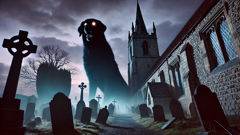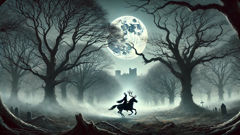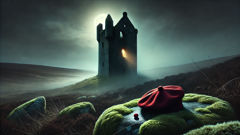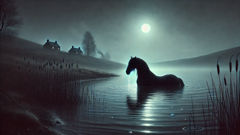Introduction
Yorkshire’s rolling moors hold secrets in their thick mists, secrets older than the stones that pave the ancient roads or the roots that anchor the twisted oaks. Among these secrets, in the village of Elderwick, stood St. Cyneburg’s Church—a squat, weathered structure with a spire that seemed to pierce the ever-shifting sky. Its flint walls, streaked by centuries of rain and lichen, leaned into the wind as if bracing for another age of stories. Yet of all the tales whispered within its nave or muttered over pints in the Dog & Sickle inn, none carried the chill or reverence of the legend of the Church Grim. This spectral black dog, seen only at the edge of vision or in the shimmer of candlelight, was both feared and honored, believed to guard the churchyard from evil and shepherd the souls of the dead. Through centuries of change—from Saxon stone masons to Norman conquerors, Puritan preachers to the everyday villagers—the presence of the Grim cast a long, shadowy protection over St. Cyneburg’s. Some claimed to have glimpsed its glowing eyes at midnight vigils; others heard its distant howl on storm-tossed nights, a sound that curled through the tombstones like the wind itself. But few knew the true origin of the Grim, or the sacrifices woven into its watchful service. In this story, we step beyond the threshold of St. Cyneburg’s into a world where the mortal and the supernatural entwine, where courage and faith are tested, and where the boundaries between guardian and legend are drawn not just in folklore, but in the hearts of those who remember. The tale of the Church Grim is more than a ghost story. It is a tapestry of love, duty, and the ceaseless battle against darkness, stitched across generations in the shadow of a single, steadfast church.
I. The First Stone and the Sacrifice
It was in the year of our Lord 1162 when the first stone of St. Cyneburg’s Church was set upon Elderwick’s highest hill. The villagers gathered, shivering in the morning damp, their breath trailing like ghosts above the frost-glazed grass. The Norman lord, Sir Osbert de Staveley, stood with arms folded, watching his masons and laborers with a hawk’s vigilance. Yet even he, for all his power, deferred to the village priest—Father Aethelric—a gentle but determined man with silver in his beard and a sadness in his eyes. For Aethelric knew the old beliefs ran deep among his flock. As the masons dug the foundation, the villagers whispered about restless spirits, about the dead disturbed by the building of a new churchyard. Some remembered the tales from the North: that a living creature must be buried beneath the first stone to anchor the church’s protection, to satisfy whatever spirits prowled the border between worlds.
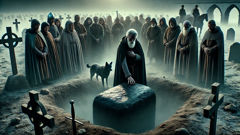
It was not a custom spoken of in Christian doctrine, but Elderwick was a place where Christianity and older faiths wove together like threads in a tapestry. Sir Osbert scoffed at such superstition, but Aethelric was not so quick to dismiss them. On the morning of consecration, as the bishop’s procession approached, a crowd gathered at the edge of the future nave. Aethelric, torn between faith and fear, made a quiet decision. He brought forth a coal-black dog—one that had wandered into Elderwick months before, gentle with the children and beloved by all. His name was Cinder. With trembling hands and a prayer whispered for mercy, Aethelric led Cinder to the foundation. The villagers looked away, unable to watch. Aethelric’s tears stained his vestments as he performed the grim task—laying Cinder to rest beneath the altar stone, murmuring promises that this sacrifice would guard them all. As the stone thudded into place, the wind seemed to sigh through the graveyard, and a single yew leaf drifted down to rest atop the mound.
For years, peace reigned. The church rose—chancel, nave, tower—each stone blessed, each arch echoing with hymns. But as autumn turned to winter, a rumor swept Elderwick: at dusk, a great black dog was seen pacing the graveyard’s edge, its eyes like coals in the gathering gloom. It chased away foxes and frightened off grave robbers. Some villagers spoke of finding lambs lost in the fields, shepherded back to their folds by an unseen companion. Others swore that if a child wandered near the churchyard at night, they’d feel a warm presence at their side—a comfort, not a threat.
Yet not all who saw the Grim felt at ease. The sexton, old Tom Fawcett, was first to claim the dog’s howl sounded before a death in the parish. His warning spread, and soon villagers left offerings—bread, milk, a sprig of yew—at the gate to appease the guardian. Father Aethelric struggled with guilt. He prayed each night for Cinder’s soul, and sometimes in the flicker of candlelight, he thought he saw a shadowy shape curled at the foot of the altar. The legend grew, passed from hearth to hearth, and Cinder’s memory became inseparable from the church he protected.
As decades passed and new generations took root in Elderwick, the story of the Grim was woven into daily life. On misty nights, parents warned their children to respect the churchyard, lest the Grim take offense. When a new vicar arrived—Father Bartholomew, a stern man from York—he dismissed the tales as pagan nonsense. But one November night, as a storm battered the steeple, Bartholomew glimpsed a hulking black shape beneath the yews. He fled inside, heart pounding, and never spoke against the Grim again. The villagers noticed his newfound respect, and in their hearts, they thanked Cinder once more.
It was said that on the anniversary of the church’s consecration, the Grim could be seen standing atop the altar stone, guarding the sacred space from whatever darkness lingered at the edge of the world. Some believed he could sense evil intent—driving away thieves, comforting mourners, and even guiding lost souls to rest. Through famine, plague, and war, St. Cyneburg’s stood unbroken, its protection as enduring as the memory of a black dog’s sacrifice.
II. The Witch of Elderwick
Centuries rolled on. The story of the Church Grim passed from grandmother to grandchild, sometimes with shivers, sometimes with comfort. The village changed—stone cottages replaced timber huts, fields sprawled wider under new lords. Yet St. Cyneburg’s stood constant, its gravestones growing mossy, its yews growing thick. In 1631, Elderwick was no stranger to suspicion. The shadow of witch hunts swept England, and in these times, fear was as sharp as winter wind. Among Elderwick’s people lived Mags Wetherill—a midwife, healer, and keeper of older wisdom. Her garden brimmed with foxglove and rosemary; her cottage glowed with herbal smoke. Mags kept to herself, her only companion a crippled raven named Hob. Some villagers brought her bread or coin for remedies. Others whispered that her touch could call storms or cure barren fields.
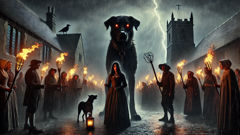
One spring, disaster struck. The vicar’s youngest son, Thomas, fell gravely ill. No prayer or physician could break his fever. In desperation, the vicar’s wife went to Mags. The old woman brewed a tincture by moonlight, her hands sure despite their tremble. She asked only for silence in return. Miraculously, Thomas recovered. Yet envy and fear are twin flames—neighbors muttered about Mags’ power, about bargains struck with dark things in the night. When a sudden blight ruined the barley crop, fingers pointed. Accusations flared. The village gathered in the square, demanding justice. Mags was dragged from her cottage, Hob flapping uselessly at her side. The vicar hesitated, torn between gratitude and dread. In the chaos, a storm rolled in—lightning split the sky, rain lashed the stones.
As they reached the churchyard gates, a deep, guttural growl froze every tongue. Out of the rain stepped the Church Grim—a massive black dog, fur slicked with water, eyes burning like lanterns. He positioned himself between Mags and her accusers, teeth bared but silent. The bravest among them—a smith’s apprentice—tried to push past. The Grim lunged, jaws snapping inches from his hand. No one else dared move. For long minutes, the Grim stood guard, rain pouring down his back, Hob perched atop his haunches like a shadowy king. At last, the vicar spoke: “Let her be judged by God, not by fear.” Shamed, the villagers retreated, leaving Mags trembling but alive.
That night, Mags sat in her cottage, candle guttering as she stitched up Hob’s wounded wing. The Grim watched from her doorstep, his eyes gentle now. She set out a bowl of broth and a crust of bread. The dog sat beside her in the darkness, an unspoken truce between old magic and new faith. Rumors spread that Mags could speak with the Grim, that she’d been spared by powers older than the church itself. But Mags knew—her life was owed not to sorcery, but to the loyalty of a soul who’d once been just a lost dog.
As seasons changed, Elderwick slowly forgot its fear. The Grim’s legend deepened—now a symbol of protection for all outcasts and innocents. On moonlit nights, some swore they saw Mags and the Grim walking the edge of the moor together, Hob circling above. The witch-hunters never came again. And when Mags finally passed—her hair white as snow, her garden wild and fragrant—the Grim was seen sitting at her grave until dawn, his head bowed as if in mourning for a friend.
III. The War and the Bells
By the dawn of the nineteenth century, Elderwick had faded into a sleepy backwater. Its days of conflict seemed over, but the world beyond was restless. In 1914, with the thunder of war rolling across Europe, change came to even this quiet corner of Yorkshire. Young men marched away in uniform, leaving behind mothers who wept in silence and fathers who bowed their heads in silent prayers within St. Cyneburg’s. As bombs fell on distant cities and telegrams brought grim news, the village clung to its rituals—Sunday bells, Christmas feasts, and the ever-watchful Grim.
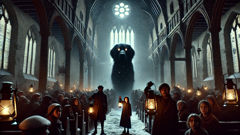
The Church Grim was now spoken of as much in jest as in reverence. Some said he’d become little more than a comforting shadow, a tale to quiet children. Yet for Elsie Turner—a spirited girl of twelve, whose father had joined the Yorkshire Regiment—the legend was real. Elsie often slipped from her bed at night, drawn to the churchyard by a sense she could not name. There, she would find the Grim waiting at the gate. His fur glistened blue-black in moonlight; his eyes were kind. Sometimes he’d nuzzle her hand or walk at her side as she wandered among the stones.
One bitter January, a stranger arrived in Elderwick—a deserter fleeing from the horrors of war. He sought shelter in the church tower, shivering as snow drifted through broken glass. Elsie found him one evening while visiting her father’s grave. The man begged for help; fear and shame had hollowed out his face. Elsie brought him bread and a woolen blanket, never telling a soul. But word of a prowler soon spread, and suspicion fell on old rivals and newcomers alike. The vicar organized night patrols. Tension ran high; the village felt on the verge of tearing itself apart.
Then came the night when the bells tolled out of season—deep, echoing, wild. Villagers rushed from their homes, lanterns swinging. The tower door was open, wind howling through its narrow stairs. Inside, they found Elsie standing beside the stranger—and between them and the rest of the village stood the Grim. He was larger than ever, his presence filling the nave with shadow and light. He barred their way with a low growl that stilled every tongue. Elsie spoke: “He’s lost and afraid, like all of us.” For a moment, the past and present seemed to blur—the Grim was both legend and reality, guardian and judge.
The vicar lowered his lantern. “Let him go,” he said quietly. “Let mercy be our memory.” The villagers parted, watching as the stranger slipped away into the snow. Elsie lingered in the churchyard, feeling the Grim’s breath warm on her fingers. In the days that followed, news came that peace was declared. The bells rang in celebration this time, and Elderwick learned that sometimes courage meant forgiveness—not punishment.
As years passed, Elsie grew into a wise woman known for her kindness. She told her children and grandchildren of the Grim who guarded not just stones and bones, but hearts weighed down by sorrow and fear. The Church Grim remained—a silent watcher, a comfort in the dark, an enduring promise that even in war and loss, hope could be found.
Conclusion
The centuries blurred and the world changed around Elderwick and its steadfast church. Cars replaced carts; neon lights crept ever closer to the moors; names on gravestones faded until only moss could read them. But through every season, every sorrow and celebration, the legend of the Church Grim endured—a thread binding past to present. For some, he was just a story to tell on stormy nights; for others, he was a guardian as real as stone and rain. Yet all who paused in the shadow of St. Cyneburg’s felt it: a presence watching over them, fierce but gentle, ancient yet familiar.
To stand before the old church at dusk was to sense the boundaries between worlds thinning—the wind carried whispers of sacrifice and mercy; the moonlight painted the outline of a black dog on the grass. Children still left bread and milk at the gate on All Hallows’ Eve, while elders nodded knowingly, grateful for traditions that outlast fear. The Church Grim remained not just as a protector of graves or a warning to evildoers, but as a symbol of what a community could become when it faced darkness together—with compassion, humility, and courage.
In every act of forgiveness, every kindness shown to outcasts or strangers, the spirit of the Grim lived on—reminding Elderwick that love and sacrifice could shape not just stories, but the very soul of a place. And so it is said that as long as St. Cyneburg’s stands beneath Yorkshire’s endless sky, a black dog will walk its churchyard—eyes bright with memory, heart steadfast as legend.

